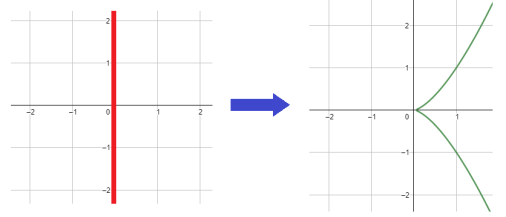Morphisms in Algebraic Geometry
Next we study the “nice” functions between closed subspaces of .
Definition.
Suppose
and
are closed subsets. A morphism
is a function which can be expressed as:
for some polynomials
. We also say f is a regular map.
Example
- Let
be any closed subset. Regular maps of the form
are given by polynomials
.
- Take
and
. Define
by
. We write this as
.
- Take
and
. Define
by
. We write this as
.

[Example 3: image edited from GeoGebra plot.]
The first example, although basic, is of huge importance.
Definition.
A regular function for a closed subset
is a morphism of the form
.
The set of such functions is called the coordinate ring of V and is denoted by
.
Note
Each regular function is given by and two polynomials f, g induce the same function on V if and only if
Thus we have , which gives k[V] its ring structure. To describe this ring structure in terms of regular functions, we have:

Morphisms in Algebra
General morphisms can now be described in the language of their coordinate rings.
Proposition 1.
Let
and
be closed. There is a bijection between:
- morphisms
;
- ring homomorphisms
which are linear over k.
Note
The second condition can be rephrased as: is a homomorphism of k-algebras. In a later article, we will cover algebras over a ring in greater detail.
Proof
Given a morphism , upon composing with a regular function
, we obtain a regular function
of V. This gives a ring homomorphism
which is clearly linear over k.
Conversely, suppose is a ring homomorphism which is linear over k. Let
be the images of
in
. Let
which is a regular function
. We claim that the function
has image in W. Indeed for any we have
which is 0 since in k[W]. This creates a bijection. ♦
Note
In order to swap we require
to be a ring homomorphism linear over k. E.g. if
with
then
The following properties are obvious:
Lemma.
- For any closed set V, we have
.
- For any morphisms
of closed sets we have
Proof
The first is clear. For the second, pick any , a regular map
. Then
. ♦
Examples
Let us interpret the earlier examples as homomorphisms .
Example 2. We have:
.
We wrote this as for a reason, for f corresponds to:
Example 3. Similarly
was written as . Algebraically,

Properties
Since we defined a topology on closed sets, the morphisms should be continuous.
Proposition 2.
A morphism
is a continuous map, with respect to the subspace topology on both sets.
Proof
Let W’ be a closed subset of W, so it is also a closed subset of . We need to show
is closed in V (equivalently, in
. Now W’ can be written as
for some subset . It follows that
is cut out from V by equations . Hence
is closed. ♦
Isomorphisms
Definition.
Closed subsets
and
are said to be isomorphic if there exist regular maps
and
such that
and
.
This implies:
Hence isomorphism of the closed subsets corresponds to isomorphism of the underlying k-algebras!
Example
Let us take example 3 from above, where is defined by
. Note that f is bijective on the points, and it corresponds to:
The image of is not surjective since it does not contain T. We have thus learnt:
 There exist bijective regular maps
There exist bijective regular maps which are not isomorphisms.

More General Correspondence
Putting it together, we obtain the following bijective correspondences:

- The top correspondence was the original one.
- The left correspondence follows from point-set topology.
- The right correspondence follows from the correspondence between ideals of
and ideals of
containing
.
- The correspondence preserves radical ideals because
is a radical ideal of A if and only if
is a reduced ring; now apply
.
- The correspondence preserves radical ideals because
Summary.
In other words, we have a bijection between radical ideals of the coordinate ring k[V] and closed subsets of V. This enables us to look at V and its coordinate ring k[V], ignoring the ambient affine space it sits in.


Could you please explain further the last sentence “This enables us to look at V and its coordinate ring k[V], ignoring the ambient affine space it sits in.”? Is it not the case that we need to consider some ambient affine space while we consider some closed subspace V it sits in?
Yes, for now. In a few articles, you will see how this pan out, where we define an abstract variety as a k-algebra.